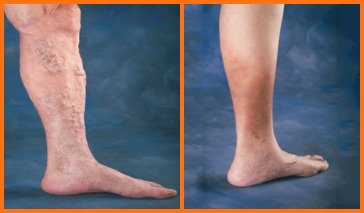The Venefit procedure, formerly known as the VNUS Closure procedure, is used to treat varicose veins and chronic venous insufficiency (CVI). Considered a minimally invasive treatment, it uses radiofrequency energy to collapse and close diseased veins. Blood then naturally reroutes itself through healthy veins. The Venefit™ procedure was developed by Covidien, an Ireland-based medical devices company.
It’s an alternative to older methods which required much more intensive surgeries – and longer recovery times – to remove diseased veins.
Conditions treated with Venefit
Both varicose veins and CVI usually affect your legs. Varicose veins are bulging and twisted red, blue or flesh-colored veins that protrude on the surface of the skin. You get varicose veins when the valves that carry blood from your legs to your heart stop functioning. This makes blood pool in your legs. Varicose veins may be a mere cosmetic concern, or they might cause pain.
If left untreated, varicose veins can progress to CVI. This condition causes your veins to lose their form, expand and bulge beneath your skin. You might experience swelling, pain, fatigue and a feeling of heaviness in your legs. Severe cases include ulcers on your skin.
How Venefit compares to other procedures
Vein stripping predates Venefit. This procedure is usually done under general anesthesia. A surgeon makes an incision in your groin, ties off the vein slated for removal, then uses a tool called a stripper. The doctor threads the stripper through your leg vein, then pulls it out through an incision in your calf. Venefit™ is done with local anesthesia. It is usually less painful and recovery is quicker.
Laser ablation is more similar to Venefit. But instead of using radiofrequency energy, laser ablation uses heat to collapse and close the desired vein. The intense heat can reach 700 degrees Celsius, which can destroy the vein walls and cause more post-treatment pain and bruising than Venefit. The Venefit device heats up to a maximum temperature of 120 degrees Celsius.
Who is a candidate for Venefit?
Men and women of a wide age range have benefited from the Venefit procedure. Vein specialists assess whether this treatment can improve your varicose veins or CVI on a case by case basis. Your specialist will want to do a complete ultrasound examination to determine whether Venefit can help you.
What to expect during the procedure
Venefit is usually done in a clinic or hospital as an outpatient procedure. You will be given local or regional anesthetic.
The doctor makes a small incision below your knee to insert the Covidien ClosureFast catheter. The catheter is attached to a Covidien’s ClosureRFG generator, which provides the radiofrequency energy that closes the vein.
Your doctor will advance the catheter up to the top of the affected vein. He or she uses ultrasound guidance to deliver anesthesia to the segment of your vein being treated. The Venefit procedure heats 7 centimeters of your vein at a time. It takes 20 seconds to collapse each 7 centimeters of vein. Your doctor may also add external pressure. Once one segment is done, the catheter is repositioned. The generator provides constant feedback that helps your doctor monitor progress.
In three to five minutes, a 45-centimeter vein can be treated. Depending on how many veins your doctor is treating, the Venefit procedure usually takes 45-60 minutes. However, expect to spend two to three hours at the facility for pre- and post-treatment procedures.
After a Venefit procedure
After Venefit, you might feel mild pain. Your doctor will probably want you to keep your legs wrapped in Ace bandages for at least 24 hours, and may require compression stockings after that.
You might need to refrain from submerging your legs – swimming or baths – for approximately two weeks, until the puncture wound heals. Avoid standing or sitting in the same position for more than two hours at a time. Your doctor will probably restrict your exercise for a couple of weeks to avoid sweating.
Expect bruised thighs after the procedure. In rare cases, patients experience leg swelling or bleeding at the puncture site. If you develop severe pain, a fever of more than 101.5, abrupt swelling or bleeding that continues for more than 20 minutes, call your doctor.
Your doctor will want to see you for follow-up appointments. Don’t fly in an airplane until your doctor has cleared you.
Risks and concerns
All surgeries and procedures bring some risk. While most patients experience only minimal pain, bruising and scarring from Venefit, more serious side effects occasionally happen. Possible complications of include infection, numbness, skin burn, perforation of blood vessels, pulmonary embolism and thrombosis.
Results of the procedure
A 2009 six-center study found several advantages of the Venefit process over laser ablation. These include less pain and bruising, faster recovery time and fewer complications. Patients experienced little to no scarring from Venefit. While this procedure is not designed for cosmetic surgery, cosmetic improvements are a byproduct.
A three-year European study of Venefit published in the Journal of Vascular Study reported a 93 percent effectiveness rate in treating veins.
Cost of Venefit
Since Venefit is done as a medically necessary – rather than cosmetic – surgery, most insurance plans cover all or most of the cost.
Reviewed February 9, 2017


